June 7th Scots book of days
 June 7 222 Pestilence in Caledonia destroyed 100,000 lives. Scotland (Sounds Excessive.) Caledonia is the Latin name given by the Romans to the land in today’s Scotland north of the Roman province of Britannia. New Caledonia, discovered in 1774 by Captain James Cook, was so named because Cook thought the mountains reminded him of his native Scotland mountains.
June 7 222 Pestilence in Caledonia destroyed 100,000 lives. Scotland (Sounds Excessive.) Caledonia is the Latin name given by the Romans to the land in today’s Scotland north of the Roman province of Britannia. New Caledonia, discovered in 1774 by Captain James Cook, was so named because Cook thought the mountains reminded him of his native Scotland mountains.
- Sometime this year. Romans abandon Britain forever. Tytler’s History of Scotland from Britannica 4.
480 epidemic pestilence in Scotland;
502 Scotland visited by epidemic disease which destroyed both man and beasts.
- Scotland suffered from epidemic pestilence.
784 Pestilence invaded Scotland.
922 A pestilential fever prevalent; very fatal in Scotland.
934 Æthelstan’s army reached Nottingham. The Annals of Clonmacnoise state that “the Scottish men compelled [Æthelstan] to return without any great victory”, while Henry of Huntingdon claims that the English faced no opposition. A negotiated settlement may have ended matters: according to John of Worcester, a son of Constantine was given as a hostage to Æthelstan and Constantín himself accompanied the English king on his return south.
1153 A ‘miserable dearth’ in Scotland, followed by a violent pest, but not contagious to man and beast. P. 339.
1264-1266 Swarms of the palmer-worm (larva of Calandra) destroyed all vegetation in Scotland.
1304 War Wolf, Lupus Guerre, a siege machine created for King Edward Ist to break Stirling Castle. Receipts survived – Latin – Domino Alexandro le Convers, pro denariis per ipsum datis,…, carpentariis facientibus ingenium quod vocatur Lupus Guerre, et aliis operaris diversis operantibus, … mensibus Maii et Junii anno presenti (1304), viio die Junii, …. 10 s.
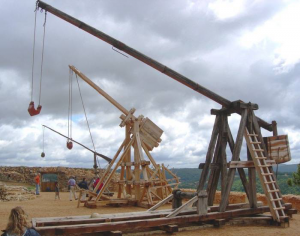 Modern English translated – “To Master Alexander le Convers, for money paid by him to the carpenters making the engine called ‘War Wolf’, and other workers working (also on the engine), in May and June 1304, 10 shillings on 7 June 1304.”
Modern English translated – “To Master Alexander le Convers, for money paid by him to the carpenters making the engine called ‘War Wolf’, and other workers working (also on the engine), in May and June 1304, 10 shillings on 7 June 1304.”
Latin Thome de Viridi Campo, valleto regine, de dono regis in recompensacionem laboris quem sustenit circa facturem Lupus Guerre quem rex fieri ordinavit pro insultu castri de Stryvelyn, ….. xl li.
“To Thomas de Viridus Campus, the queen’s valet, recompensed at the King’s hand for his labours in the making of the ‘War Wolf’, which the King ordered to be made to slight Stirling Castle, £40.”
The sight of the catapult so intimidated the Scots that they offered surrender. Edward sent the truce party back inside the castle, declaring, “You don’t deserve any grace, but must surrender to my will.”[1] Edward decided to carry on with the siege and witness for himself the power of the masterful weapon. The Warwolf accurately hurled missiles weighing as much as three hundred pounds (~136 kg) and levelled a large section of the curtain wall. Slighting is the deliberate destruction, partial or complete, of a fortification without opposition, to render it unusable as a fortress. Wikipedia
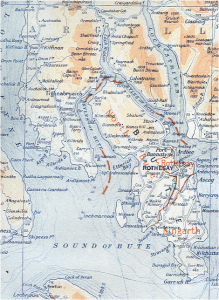 1329 Cardross, Dumbartonshire, Argyll and Bute. 1845 Map of Argyll and Bute, Sound of Bute, Robert the Bruce died. (age 55) Robert b 11 July 1274, married 1) Isabella of Mar, 2) Elizabeth de Burgh, d June 7, 1329. Son, David Bruce 2nd king of Scots, age 5 succeeds as King. Anderson’s Scots History v.2/p.25-27.
1329 Cardross, Dumbartonshire, Argyll and Bute. 1845 Map of Argyll and Bute, Sound of Bute, Robert the Bruce died. (age 55) Robert b 11 July 1274, married 1) Isabella of Mar, 2) Elizabeth de Burgh, d June 7, 1329. Son, David Bruce 2nd king of Scots, age 5 succeeds as King. Anderson’s Scots History v.2/p.25-27.
- Brus or Bruce 1050 2Stewart2Kennedy 2Montgomery2Blair 2Cochrane2Miller 2Simmons2Choate zoe ToaG
Tytler’s Britannica p.55. Bruce buried under the choir in Abbey Church of Dunfermline. The king’s dying command was to carry his heart to Jerusalem for the Church of the Holy Sepulchre, and Sir James Douglas, reached Seville, only to be attacked and killed by the Moors. The heart of Bruce was returned to Melrose Abbey.
1330 The harvest late, plague in Glasgow. P 340.
1342 A terrible plague in Scotland, which destroyed one-third of the population.
1348, the plague reached England, and extended to the northern counties. It was thence conveyed by the Scottish army to Scotland and there raged with peculiar violence.
1361 sometime in, pestilence in Scotland. 1361 A great dearth, and pestilence in England.
1362, 1367, 1369. Pestilence and Dearth, Scotland, In London and Paris.
1380 ‘A contagious diseases’ imported from England into Scotland by means of reckless Borderers in their raids. The different pestilences which occurred between 1350 and this date 1380 are considered not to have included ‘plague’ properly so called.
1381 Plague raging in Glasgow.
1419-24 A contagious distemper resembling a fever an dysentery prevailed in England and Scotland.
1510 ‘Stoope galant’ in Scotland.
1512 Plague in Perth. P 349
1513 Plague in Edinburgh. P 349
1514 The Plague in Scotland, particularly in Aberdeen.
1546 Plague also in Scotland (Aberdeen)
1568 Plague also in Edinburgh, into which city the disease was introduced by human means. P.353.
1585 In Edinburgh plague broke out in the month of May and continued till January following. P. 354
1587 Plague persisted in Scotland.
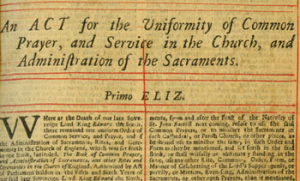 1534 to 1607 to 1641. Religious persecution laws adopted at various times in these years. The Act of Uniformity, the Test Acts and Penal Laws of England, (with jurisdiction into Ireland, Scotland and British colonies of Africa, India, and Americas), enforced by execution and torture, fine and prison, confiscation and transport to the plantations (American colonies, if ye weren’t already here) were, according to Edmund Burke “a machine of wise and elaborate contrivance, as well fitted for the oppression, impoverishment and degradation of a people, and the debasement in them of human nature itself, as ever proceeded from the perverted ingenuity of man.” Savage, John (1869). Fenian Heroes and Martyrs. Patrick Donahoe. pp. 16. Bans on Catholics, Dissenters from the Established Church, (Nonconformists, Presbyterians, Lutherans, Quakers, Covenanters, Methodists, Congregationalists, Jews, Anglicans 1650-1661, Baptists, along with slaves, felons, imbeciles. and foreigners) No person of the popish religion shall publicly or in private houses teach school, or instruct youth in learning within this realm’ upon pain of twenty pounds fine and three months in prison for every such offence. Repealed in 1782. Wikipedia.
1534 to 1607 to 1641. Religious persecution laws adopted at various times in these years. The Act of Uniformity, the Test Acts and Penal Laws of England, (with jurisdiction into Ireland, Scotland and British colonies of Africa, India, and Americas), enforced by execution and torture, fine and prison, confiscation and transport to the plantations (American colonies, if ye weren’t already here) were, according to Edmund Burke “a machine of wise and elaborate contrivance, as well fitted for the oppression, impoverishment and degradation of a people, and the debasement in them of human nature itself, as ever proceeded from the perverted ingenuity of man.” Savage, John (1869). Fenian Heroes and Martyrs. Patrick Donahoe. pp. 16. Bans on Catholics, Dissenters from the Established Church, (Nonconformists, Presbyterians, Lutherans, Quakers, Covenanters, Methodists, Congregationalists, Jews, Anglicans 1650-1661, Baptists, along with slaves, felons, imbeciles. and foreigners) No person of the popish religion shall publicly or in private houses teach school, or instruct youth in learning within this realm’ upon pain of twenty pounds fine and three months in prison for every such offence. Repealed in 1782. Wikipedia.
1628 – The Petition of Right taxes can be levied only by Parliament, that martial law may not be imposed in time of peace, and that prisoners must be able to challenge the legitimacy of their detentions through the writ of habeas corpus. The Petition’s ban on the billeting of troops is reflected in the Third Amendment to the United States Constitution.
In 1626, Charles 1st had convened Parliament in an effort to obtain desperately needed funds for the continuation of his unsuccessful war with Spain. Unhappy with the prosecution of the war, however, Parliament swiftly began impeachment proceedings against Charles’ favorite and principal counselor, the Duke of Buckingham. In order to protect Buckingham, Charles 1st was forced to dissolve Parliament before it had voted any subsidies. Left without recourse to parliamentary taxation, 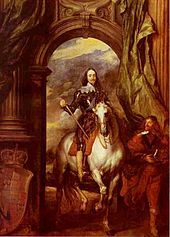 Charles 1st resorted to two forms of extra-parliamentary taxation to raise the funds he needed – a benevolence and a Forced Loan – that were of doubtful legality at best. He also began to billet soldiers in civilian homes, both as a cost-saving measure and as a means of punishing his political opponents. Citing the Forced Loan’s illegality, a number of gentlemen refused to pay, and many of them were imprisoned as a result. Ultimately, five of the imprisoned gentlemen – the so-called “Five Knights” (since they were all knights) – petitioned the Court of King’s
Charles 1st resorted to two forms of extra-parliamentary taxation to raise the funds he needed – a benevolence and a Forced Loan – that were of doubtful legality at best. He also began to billet soldiers in civilian homes, both as a cost-saving measure and as a means of punishing his political opponents. Citing the Forced Loan’s illegality, a number of gentlemen refused to pay, and many of them were imprisoned as a result. Ultimately, five of the imprisoned gentlemen – the so-called “Five Knights” (since they were all knights) – petitioned the Court of King’s 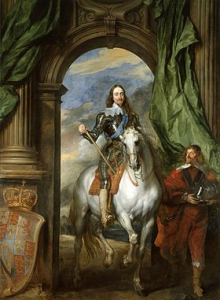 Bench for writs of habeas corpus to force the government to specify the reason for their imprisonment. Seeking to avoid a direct challenge of the legality of the Loan, Charles 1st refused to charge the prisoners with a specific crime, instead declaring on the return to the writs that the knights were detained “per speciale mandatum domini regis” (“by special command of our lord the king”). Portrait of Charles I with Seignior de St Antoine
Bench for writs of habeas corpus to force the government to specify the reason for their imprisonment. Seeking to avoid a direct challenge of the legality of the Loan, Charles 1st refused to charge the prisoners with a specific crime, instead declaring on the return to the writs that the knights were detained “per speciale mandatum domini regis” (“by special command of our lord the king”). Portrait of Charles I with Seignior de St Antoine
1643 The ‘pest’ in Edinburgh, preceded by drying of the wells. P 348
1644 The Plague in Scotland, especially fatal in Edinburgh and in Falkirk.
1647-48. A highly malignant pestilence in Scotland; its greatest fatality at Glasgow and Largs. P. 358.
1648 first Sunday of june. In June of 1648, members of the Kirk party gathered in Mauchline to join in a celebration of the Eucharist that lasted several days. The Whiggamore Raid (or “March of the Whiggamores”) was a march on Edinburgh by supporters of the Kirk party of the Covenanters to take power from the Engagers whose army had recently been defeated by the English New Model Army at the Battle of Preston (1648). 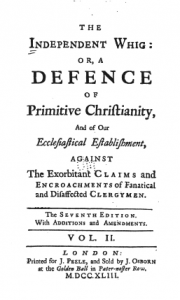 1743 Independent Whig: or, a Defence of Primitive Christianity, And of Our Ecclesiastical Establishment, against The Exorbitant Claims and Encroachments of Fanatical and Disaffected Clergymen. The Seventh Edition, with Additions and Amendments (London: J. Peele, 1743). Vol. 2.
1743 Independent Whig: or, a Defence of Primitive Christianity, And of Our Ecclesiastical Establishment, against The Exorbitant Claims and Encroachments of Fanatical and Disaffected Clergymen. The Seventh Edition, with Additions and Amendments (London: J. Peele, 1743). Vol. 2.
Whiggamores (later shortened to Whigs)—a term most likely originating from the Scots for “mare drivers”—became a nickname for the Kirk party who were against the Engagement with King Charles I.
1706-1707 Epidemic pestilence in Scotland.
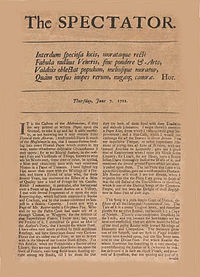 1711 – The Spectator was a daily publication of 1711–12, founded by Joseph Addison and Richard Steele in England after they met at Charterhouse School. The Spectator from June 7th, 1711.
1711 – The Spectator was a daily publication of 1711–12, founded by Joseph Addison and Richard Steele in England after they met at Charterhouse School. The Spectator from June 7th, 1711.
The Ballad of Chevy Chase, the story of a large hunting party upon a parcel of hunting land (or chase) in the Cheviot Hills, is based on the events of the Battle of Otterburn on August 19th, 1388. Chevy Chase Maryland is a suburb of Washington, District of Columbia.
In 1711 Joseph Addison wrote in The Spectator. The old song of “Chevy-Chase” is the favourite ballad of the common people of England, and Ben Jonson used to say he had rather have been the author of it than of all his works. Sir Philip Sidney, in his discourse of Poetry, speaks of it in the following words: “I never heard the old song of Percy and Douglas that I found not my heart more moved than with a trumpet; and yet it is sung by some blind crowder with no rougher voice than rude style, which being so evil apparelled in the dust and cobweb of that uncivil age, what would it work trimmed in the gorgeous eloquence of Pindar?” For my own part, I am so professed an admirer of this antiquated song, that I shall give my reader a critique upon it without any further apology for so doing.
1728 Scarlet fever in Edinburgh. P. 363.
1734 Scotland, a pestilence in man, horses (influenza), dogs and fowls.
1755 Braddock’s March, Alexandria Virginia. Sir Peter Halkett marched out with a contingent of British and American troops. Halket Crest: A falcon’s head erased Proper Motto: FIDES SUFFICIT [“Faith is sufficient”] Seat: Pitfirran, Fife 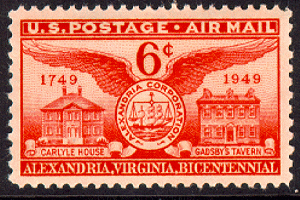 John Carlyle home, Alexandria seal, Gadsby’s Tavery. 1949. Scottish merchants founded a village in 1732, which they named Belhaven. In
1749, by act of the Virginia House of Burgesses, the town was established and
renamed Alexandria. Although the town was included within the boundaries of the
District of Columbia in 1791, it was returned to Virginia in 1846 as an
independent city, free of county affiliations. usstampgallery.com
John Carlyle home, Alexandria seal, Gadsby’s Tavery. 1949. Scottish merchants founded a village in 1732, which they named Belhaven. In
1749, by act of the Virginia House of Burgesses, the town was established and
renamed Alexandria. Although the town was included within the boundaries of the
District of Columbia in 1791, it was returned to Virginia in 1846 as an
independent city, free of county affiliations. usstampgallery.com
1761 – John Rennie, born. Scottish engineer (d. 1821)
1764 Pestilential disease in Scotland.
1772 Small-pox rife in Scotland.
1780 Newgate, King’s Bench, Fleet prisons, and homes of Roman Catholics burned. 26 fires at the same time. Tytler’s Britannica.
1799 Scotland cattle plague.
1828 – in Scotland, anthrax P. 376. 1839-44 in Scotland, Louping-ill.
1831 Sabbath. Joseph Smith the Prophet, in Kirtland, Ohio,, (clans Huntley, Hamilton, Mackenzie, Mack of Inverness, Malcolm King O Scots) Doctrine and Covenants 52. And remember in all things the poor and the needy, the sick and the afflicted,
1832 Plan of parliamentary reform bill royal assent given. Tytler’s Britannica.
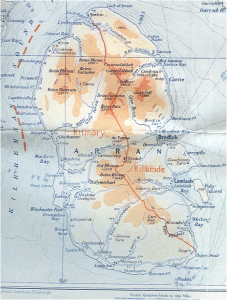 1840 Blight among the crops in Germany, especially the potato, A similar disease appeared in the Island of Arran, and other parts of the Highlands of Scotland. In Scotland influenza in horses. 1845 map of Arran.
1840 Blight among the crops in Germany, especially the potato, A similar disease appeared in the Island of Arran, and other parts of the Highlands of Scotland. In Scotland influenza in horses. 1845 map of Arran.
1846-47. Epidemic remittent fever in Scotland, A similar fever prevailed in Glasgow in 1740, 1745 1764 1765
1859 Cholera recurred in various places in Scotland.
1860 – Lymph scrotum. Case published in Edinburgh Medical journal, by Dr. Wong-Fun of Kumloefon, near Canton. p 157
1868 – Charles Rennie Mackintosh, Scottish architect, designer, and water colourist (d. 1928)
1879 effective method of treating ulcers, a piece of the leaden lining of a tea box is beaten out smooth and laid carefully upon he ulcer, covering adjoining parts, several folds of lint applied so as to absorb the purulent discharge. This method of treating chronic ulcers was first introduced by Mr. Syme of Edinburgh, many years ago. P. 351.
‘Repent, repent ye, Hear the words of that God who made you, by the voice of pestilence.’ Jesus Christ in Doctrine and Covenants section 43.
An Epitome of the Reports of the Medical Officers to the Chinese Imperial Maritime Customs Service from 1871 to 1882, by Surgeon General C.A. Gordon, M.D. C.B. Honorary Physician to Her Majesty the Queen, London, 1884.
1906 – Cunard Line’s RMS Lusitania is launched at the John Brown Shipyard, Glasgow (Clydebank), Scotland.
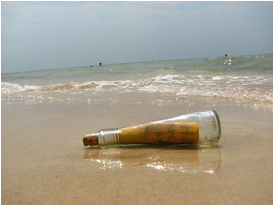 1914 Sometime this month (just before the Great war broke out). Within the bottle, a postcard written in June 1914 by Captain CH Brown of the Glasgow School of Navigation promised the finder a reward of 6 pence. It had been part of a scientific experiment in which 1,890 such bottles were released, in a bid to chart currents around Scotland. August 31, 2012. Andrew Leaper, a Scottish skipper, discovered a 98-year old message in a bottle.
1914 Sometime this month (just before the Great war broke out). Within the bottle, a postcard written in June 1914 by Captain CH Brown of the Glasgow School of Navigation promised the finder a reward of 6 pence. It had been part of a scientific experiment in which 1,890 such bottles were released, in a bid to chart currents around Scotland. August 31, 2012. Andrew Leaper, a Scottish skipper, discovered a 98-year old message in a bottle.
Read more: http://blogs.smithsonianmag.com/smartnews/2012/08/the-oldest-message-in-a-bottle-ever-found-is-98-years-old/#ixzz2Pt5Xiy40
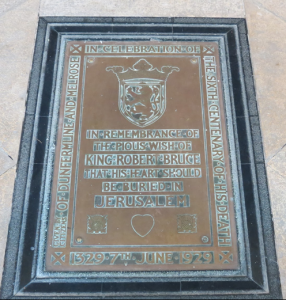 1929 In celebration of the sixth century of his death, 1329, 7 June 1929. Given by citizens of Dumfermline and Melrose. Six hundred years later, in 1921, during an excavation by His Majesty’s Office of Works, a lead container holding the embalmed heart of the Bruce was unearthed in the ruins of the chapter house at Melrose Abbey. Once the contents of the cone-shaped container were examined and ascertained, the lead receptacle was encased within a larger one with the following engraving: “The enclosed leaden casket containing a heart was found beneath Chapter House floor, March 1921, by His Majesty’s Office of Works.”
1929 In celebration of the sixth century of his death, 1329, 7 June 1929. Given by citizens of Dumfermline and Melrose. Six hundred years later, in 1921, during an excavation by His Majesty’s Office of Works, a lead container holding the embalmed heart of the Bruce was unearthed in the ruins of the chapter house at Melrose Abbey. Once the contents of the cone-shaped container were examined and ascertained, the lead receptacle was encased within a larger one with the following engraving: “The enclosed leaden casket containing a heart was found beneath Chapter House floor, March 1921, by His Majesty’s Office of Works.”
 1940 Daisy Duck in her familiar name and design first appeared in Mr. Duck Steps Out (June 7, 1940). (fictional clan McDuck) Daisy Duck in Mr. Duck steps out.
1940 Daisy Duck in her familiar name and design first appeared in Mr. Duck Steps Out (June 7, 1940). (fictional clan McDuck) Daisy Duck in Mr. Duck steps out.
 Donald visits the house of his new love interest for their first known date, and dance the jitterbug. (fictional clan McDuck)
Donald visits the house of his new love interest for their first known date, and dance the jitterbug. (fictional clan McDuck)
1940 Friday. 7th. Raritan New Jersey. Georgia. Alabama. Texas. Fort Douglas Utah. ‘Their Finest Hour, The Fall of France, Back to France.’ Generations of Government gun control and gun bans had disarmed the homefronts of Poles, and disarmed the homefronts of neutral Belgians and Dutch, and disarmed the homefronts of French, Scots, and English. Relying, as their governments promised and they falsely supposed on their police and armies. All were to pay very dearly for such short sightedness, under rape, riot, and ruin. Terrible and crushing evils would be unleashed on a defenseless, helpless and self unarmed populace. The shock of Nazi blitzkrieg devastated Poland, Belgium, Netherlands, Luxembourg, and France. Next up was Great Britain. Churchill (clan Montgomery) wrote –
- By the end of the week more than six hundred heavily loaded freight cars were rolling towards the Army docks at Raritan New Jersey, up the river from Gravesend Bay.’
Backstory, the British evacuation of Dunkirk (May June 1940) and other evacuations from Brest, Cherbourg, St. Malo, and St. Nazaire, left all their guns and equipment on the beaches of France. The United States sold a half million rifles and more to restock and rearm Scotland and England against a threatened Nazi invasion upcoming in the Battle of Britain (June to November 1940). America could spare six hundred freight cars of guns and ammo, to be shipped overseas, because the American people, many of Scots descent, individually, and in families, and in clubs, coast to coast and border to border, owned a thousand times that amount of weapons, and knew how to use them.
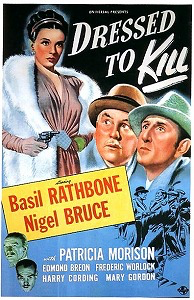 1946 Dressed to Kill, released in 1946, also known as Prelude to Murder (working title) and Sherlock Holmes and the Secret Code in the United Kingdom, is the last of fourteen films starring Basil Rathbone as Sherlock Holmes and Nigel Bruce as Doctor Watson.
1946 Dressed to Kill, released in 1946, also known as Prelude to Murder (working title) and Sherlock Holmes and the Secret Code in the United Kingdom, is the last of fourteen films starring Basil Rathbone as Sherlock Holmes and Nigel Bruce as Doctor Watson.
1946 Film poster.
1951 Happy Go Lovely released in London. A British comedy musical set in Edinburgh, Scotland. Lots of brogue, shots of the Magic 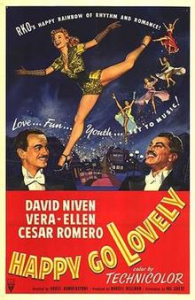 mile in Edinburgh. It is a movie about a theatrical musical, trying to get money for the production. Vera Ellen gets a ride in the richest man in Scotland’s limo, leaves her purse, and when returned, everyone thinks she is, well, beautiful, talented, young, and near rich. David Niven plays the billionaire boyfriend. Will Niven back the musial on the Edinburgh stage? The cab passes the Black Watch piper band marching down the parade route. Like every other plot, The Producers, Pygmalion, My Fair Lady, Cinderella, Heidi, the rich prince’falls in love with the beautiful but penniless milkmaid. Who knew that Vera Ellen would fall in love with David Niven (about 11 years her senior)., with mutual .
mile in Edinburgh. It is a movie about a theatrical musical, trying to get money for the production. Vera Ellen gets a ride in the richest man in Scotland’s limo, leaves her purse, and when returned, everyone thinks she is, well, beautiful, talented, young, and near rich. David Niven plays the billionaire boyfriend. Will Niven back the musial on the Edinburgh stage? The cab passes the Black Watch piper band marching down the parade route. Like every other plot, The Producers, Pygmalion, My Fair Lady, Cinderella, Heidi, the rich prince’falls in love with the beautiful but penniless milkmaid. Who knew that Vera Ellen would fall in love with David Niven (about 11 years her senior)., with mutual .
Happy Go Lovely, David Niven, Vera-Ellen,Cesar Romero. With technicolor
2007 Scotland is coming to Thanksgiving Point. LEHI — Scottish athletes like to throw things. They will get their chance, said Jeff Loosle, athletic director of the “Heavy Events,” when the Utah Scottish Association holds its ScotFest 2007. The 33rd annual Scottish Festival and Highland Games starts at Thanksgiving Point’s Electric Park. a concert that includes the Wicked Tinkers, Molly’s Revenge and Oceans Apart. “What you will see, simply, (is) some of the best Scottish athletes in the world competing at the National Sheaf Toss Championships,” Loosle said. In the sheaf toss a burlap bag, weighing 16 to 22 pounds, is thrown for height with a pitchfork. The bag has to clear the bar to be a legal throw.
Other athletic events include:
- The Braemar stone, a 22- to 30-pound stone thrown from a standing position.
- The open stone, a 16- to 21-pound stone thrown with an approach.
- A 56-pound heavy weight thrown for distance with one hand and two spins.
- A 28-pound light weight thrown with one hand, two spins, for distance.
- A heavy hammer with a 22-pound ball on a 50-inch handle thrown backward for distance.
- Weight Over Bar — a 56-pound weight thrown one-handed for height. (Weight has to clear an overhead bar.)
 “The most famous is the caber toss — a k a telephone pole/tree toss. A caber, up to 20 feet long and weighing 150 pounds, is thrown for accuracy. At a game in Pomona, Calif., last year the game’s announcer was asked, “Why do you throw telephone poles?”
“The most famous is the caber toss — a k a telephone pole/tree toss. A caber, up to 20 feet long and weighing 150 pounds, is thrown for accuracy. At a game in Pomona, Calif., last year the game’s announcer was asked, “Why do you throw telephone poles?”
http://www.deseretnews.com/article/660226907/Scotland-is-coming-to-Thanksgiving-Point.html?pg=all
Disclaimer: The author of each article published on this web site owns his or her own words. The opinions, beliefs and viewpoints expressed by the various authors and forum participants on this site do not necessarily reflect the opinions, beliefs and viewpoints of Utah Standard News or official policies of the USN and may actually reflect positions that USN actively opposes. No claim in public domain or fair use. © John Choate
Utah Standard News depends on the support of readers like you.
Good Journalism requires time, expertise, passion and money. We know you appreciate the coverage here. Please help us to continue as an alternative news website by becoming a subscriber or making a donation. To learn more about our subscription options or make a donation, click here.
To Advertise on UtahStandardNews.com, please contact us at: ed@utahstandardnews.com.


Comments - No Responses to “June 7th Scots book of days”
Sure is empty down here...